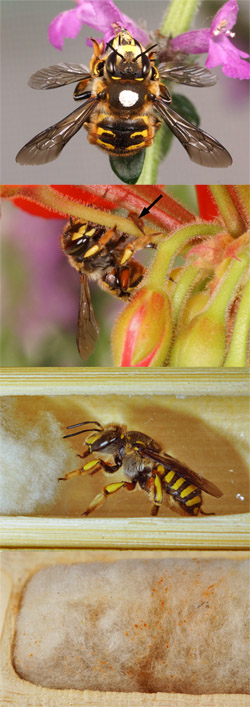Wool-carder bees |
||
Wool-carder bees (Megachilidae: Anthidiini) are solitary bees that are outstanding in two rather different behavioral contexts. Mating system: The mating system of European wool-carder bees, Anthidium manicatum, differs from that of most bees in three important aspects: females (1) are polyandrous and (2) mate continuously over the course of their reproductive life, while males (3) exhibit resource defence polygyny, that is, defend patches of food plants where copulations occur. To shed light on the evolution of this mating system we investigated male paternity using a combination of cage experiments and microsatellite genotyping of brood. We found that, although females possess a spermatheca for long-term sperm storage, most brood was fathered by males that had very recently mated with the breeding female, indicating pronounced last (or at least ‘late’) male sperm precedence and fertilization by sperm that had not yet entered the spermatheca. We suggest that 'late' male sperm precedence has coevolved with ‘resource defence’ or ‘patrolling’-like male mating strategies in Hymenoptera, and with polyandry in anthidiine bees (Lampert et al. 2014) Nest construction materials: Bees make use of plant substrates in many ways, but wool-carder bees (Anthidiini) are special for using plant hairs (“plant wool”) as their prime building material for brood cells. Some (but not all) species further impregnate the wool with trichome secretions from certain plant species. We investigated the protective effects of plant-derived extrafloral trichome secretions which female European wool-carder bees, Anthidium manicatum, smear on their brood cells. By breeding bees in cages with differential resource supply we generated brood cells with or without trichome secretions. Brood cells with trichome secretions were less attractive to chalcidoid wasps, potential parasites of A. manicatum, in Y-maze olfactometer tests. Also, when exposed at sites where A. manicatum occurs in natural populations, brood cells smeared with trichome secretions were less affected by wasp parasitism than those without trichome secretions (Eltz et al. 2015). Parasitoids are likely an underestimated cause of the diversification of cell construction materials and adaptive radiation in megachilid bees, and we continue to investigate this hypothesis in a chemical ecological and an evolutionary (phylogenetic) framework. Lampert K. P., Pasternak V., Brand P., Tollrian R., Leese F., Eltz T. (2014) ‘Late’ male sperm precedence in polyandrous wool-carder bees and the evolution of male resource defence in Hymenoptera. Animal Behaviour, 90, 211-217.PDF Eltz, T., Küttner, J., Lunau, K., Tollrian, R. (2015) Plant secretions prevent wasp parasitism in nests of wool-carder bees, with implications for the diversification of nesting materials in Megachilidae. Frontiers in Ecology and Evolution 2: 1-7. PDF |
|
RUB » Dekanat für Biologie und Biotechnologie » Evolutionsökologie und Biodiversität der Tiere - Mitarbeiterhomepage PD Dr. Th. Eltz


